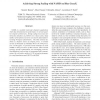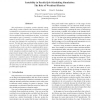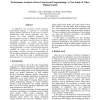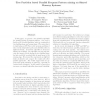IPPS
2006
IEEE
15 years 7 months ago
2006
IEEE
A self-stabilizing protocol is a brilliant framework for fault tolerance. It can recover from any number and any type of transient faults and eventually converge to its intended b...
129
Voted
IPPS
2006
IEEE
15 years 7 months ago
2006
IEEE
Modern FPGA platforms provide the hardware and software infrastructure for building a bus-based System on Chip (SoC) that meet the applications requirements. The designer can cust...
94
Voted
IPPS
2006
IEEE
15 years 7 months ago
2006
IEEE
NAMD is a scalable molecular dynamics application, which has demonstrated its performance on several parallel computer architectures. Strong scaling is necessary for molecular dyn...
119
click to vote
IPPS
2006
IEEE
15 years 7 months ago
2006
IEEE
MPI provides a portable message passing interface for many parallel execution platforms but may lead to inefficiencies for some platforms and applications. In this article we sho...
102
Voted
IPPS
2006
IEEE
15 years 7 months ago
2006
IEEE
The performance of computer systems depends, among other things, on the workload. This motivates the use of real workloads (as recorded in activity logs) to drive simulations of n...
113
Voted
IPPS
2006
IEEE
15 years 7 months ago
2006
IEEE
As multi/many core processors become prevalent, programming language is important in constructing efficient parallel applications. In this work, we build a multithreaded video min...
94
Voted
IPPS
2006
IEEE
15 years 7 months ago
2006
IEEE
We present a SAT-based approach to the task and message allocation problem of distributed real-time systems with hierarchical architectures. In contrast to the heuristic approache...
IPPS
2006
IEEE
15 years 7 months ago
2006
IEEE
IPPS
2006
IEEE
15 years 7 months ago
2006
IEEE
106
click to vote
IPPS
2006
IEEE
15 years 7 months ago
2006
IEEE
In this paper, we present a tree-partition algorithm for parallel mining of frequent patterns. Our work is based on FP-Growth algorithm, which is constituted of tree-building stag...




